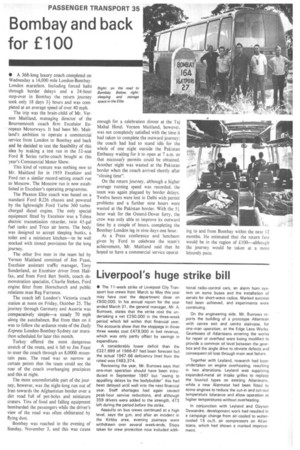Liverpool's huge strike bill
Page 37

If you've noticed an error in this article please click here to report it so we can fix it.
• The 11-week strike of Liverpool City Transport bus crews from March to May this year may have cost the department close on £900,000. In his annual report for the year ended March 31, the general manager, Mr. A. Burrows, states that the strike cost the undertaking a net £250,000 in the three-week period which fell within that financial year. The accounts show that the stoppage in those three weeks cost '£478,000 in lost revenue, which was only partly offset by savings in expenditure.
A considerably lower deficit than the £327,699 of 1966-67 had been forecast but the actual 1967-68 deficiency {met from the rates) was £483,374.
Reviewing the year, Mr. Burrows says that one-man operation should have been introduced in September 1967 but "owing to appalling delays by the bodybuilder" this had been delayed until well into the next financial year. Staff shortages had again caused peak-hour service reductions, and although 359 drivers were added to the strength, 473 left during the period before the strike.
Assaults on bus crews continued at a high level, says the g.m. and after an incident in the Kirkby area, evening journeys were withdrawn over several week-ends. Steps taken for crew protection now included addi tional radio-control cars, an alarm horn system on some buses and the installation of aerials for short-wave radios. Marked success had been achieved, and experiments were continuing.
On the engineering side, Mr. Burrows reports the building of a prototype Atlantean with centre exit and centre staircase, for one-man operation, at the Edge Lane Works. Gearboxes of Atlanteans entering the works for repair or overhaul were being modified to provide a common oil level between the gearbox and the angle drive to obviate defects and consequent oil loss through main seal failure.
Together with Leyland, research had been undertaken on engine overheating, resulting in two alterations. Leyland was supplying expanded-metal air intake grilles to replace the louvred types on existing Atlanteans, while a new Alarmstat had been fitted to some engines to reduce the cut-in and cut-out temperature tolerance. and allow operation at higher temperatures without overheating.
In conjunction with Leyland and Clayton Dewandre, development work had resulted in a campaign change from air-cooled to watercooled 15 cu.ft, air compressors on Atlanteens, which had shown a marked improvement.




















































































































